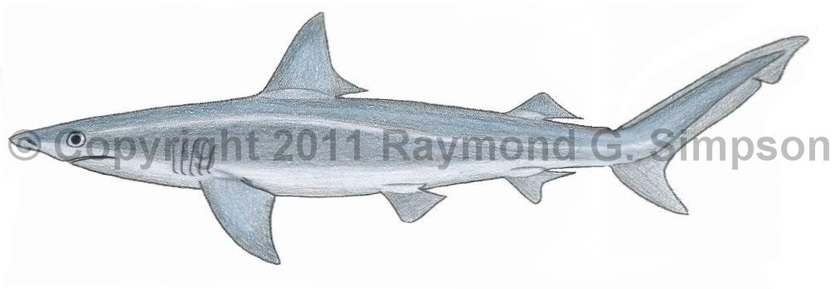
Common Name
Finetooth Shark
Year Described
Müller and Henle, 1839
Identification
Anteroposterior tooth rows: 12-15/13-14 on each side; 27-32/29-31 total
Vertebrae: 77-81 precaudal, 163-166 total
A small and slender shark with a long and pointed snout. Eye large. Distance between nostrils 1.1-1.3 times in pre-oral distance. Nasal flaps rudimentary. Upper labial furrows short. Interdorsal ridge is absent. Long preanal ridge absent. No keels on caudal peduncle. Gill slits very long (4.8-6.5% TL). Teeth in upper jaws broad based with a very narrow, erect cusp (smooth in juveniles and serrated in adults). Lower jaw teeth thick-based, with very slender, smooth, and erect cusps. First dorsal fin fairly high (7.5-10.6% TL) with a convex or straight anterior margin, a rounded to pointed tip, and inserted just posterior to origin of pectoral fin. Second dorsal fin much smaller (2.5-2.9% TL) and inserted almost directly above anal fin. Both dorsal fins with extended free posterior tips (second dorsal free tip much shorter than twice height of second dorsal). Anal fin similar in size to second dorsal fin. Pelvic fin origin well behind free tip of first dorsal. Pectoral fin small and falcate, with a pointed tip.
Color
Blue-gray to dark bronze above, grading to light gray laterally and white below. A faint white lateral stripe is often present. Fins without dark markings.
Size
Mature adults from 125-165cm TL. Newborns from 55-58cm. Maximum size to at least 190cm TL.
Habitat
Shallow coastal waters up to 10m in depth. Forms large aggregations. Migrates northward during warmer months.
Range
Continental: New York to Florida and the Gulf of Mexico to Mexico. Also Trinidad to southeastern Brazil.
References
Castro, J.I. 2011. The Sharks of North America. Oxford University Press, 640 pp.
Compagno, L.J.V. 2002. Sharks. In: Carpenter, K.E. (Editor) FAO Identification Guide for Fishery Purposes. The Living Marine Resources of The Western Central Atlantic. Volume 1: Introduction, mollusks, crustaceans, hagfishes, sharks, batoid fishes, and chimaeras. ASIH Special Publication No. 5. FAO, Rome.
Compagno, L., M. Dando, and S. Fowler. 2005. Sharks of the World. Princeton University Press, 480 pp.